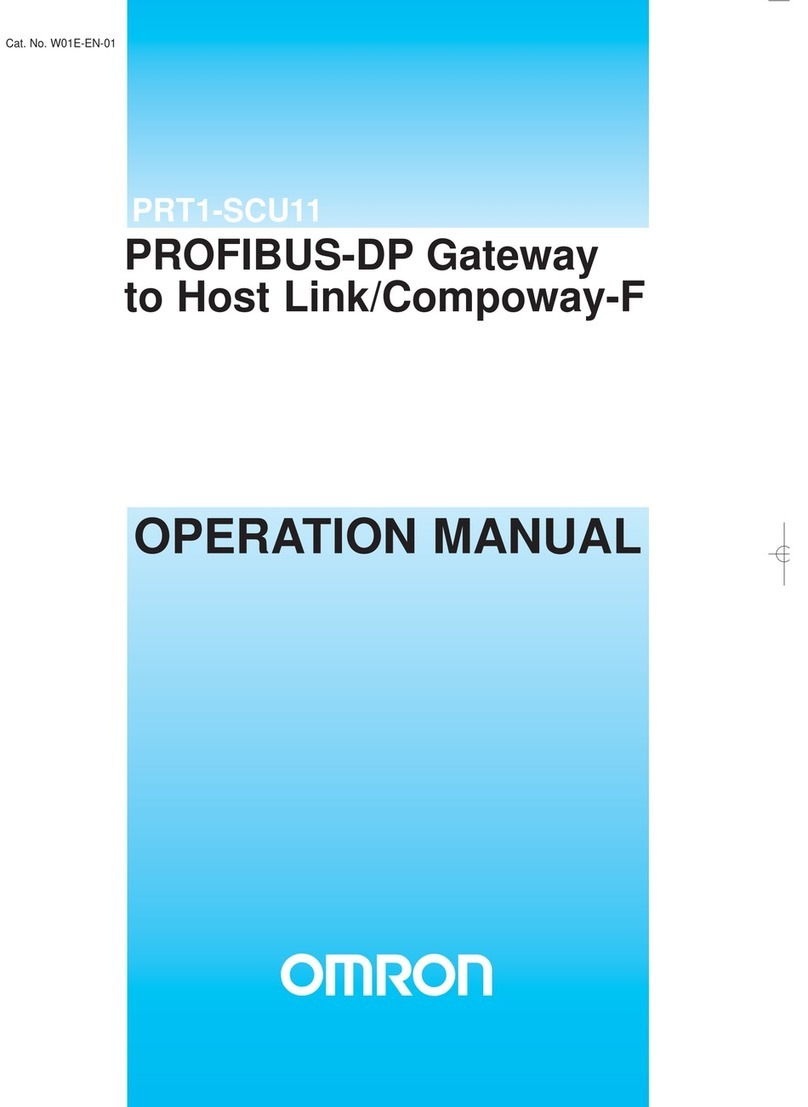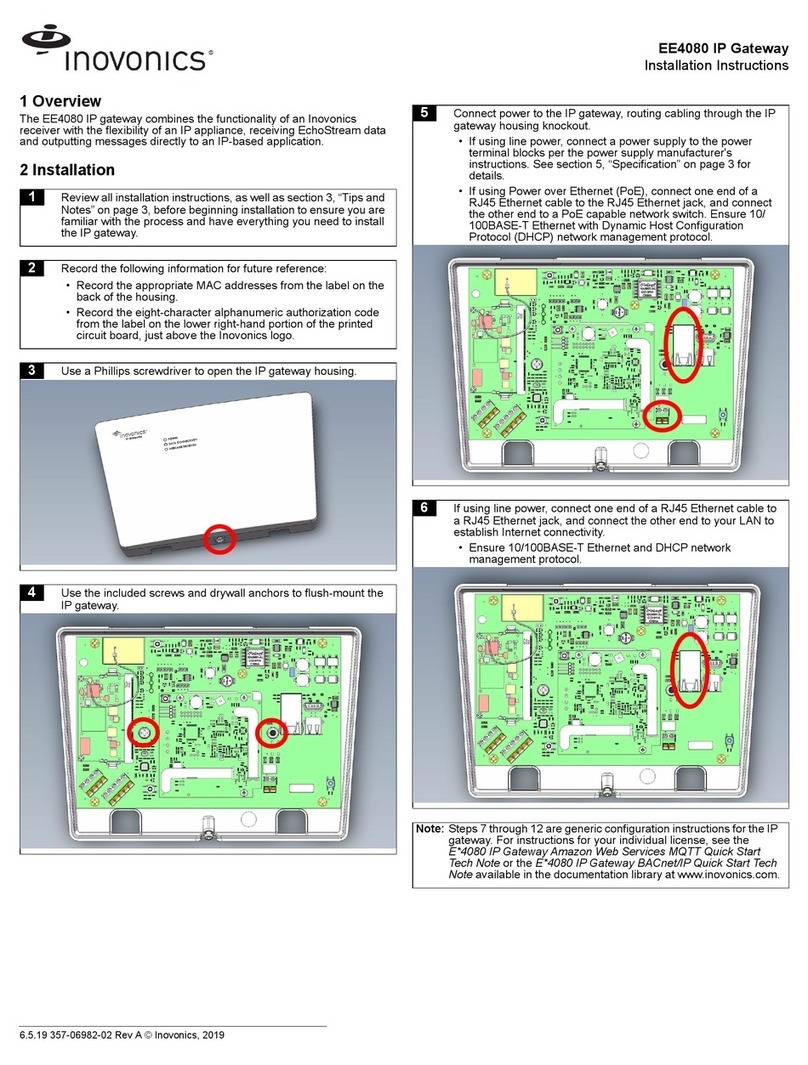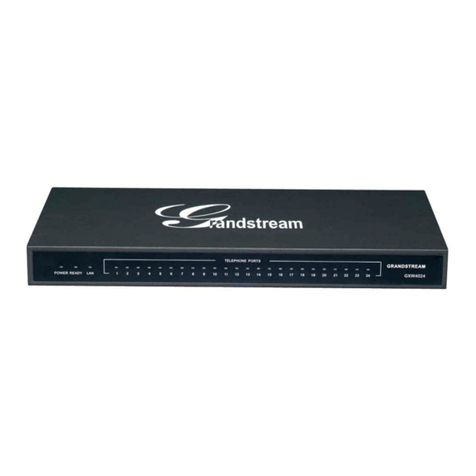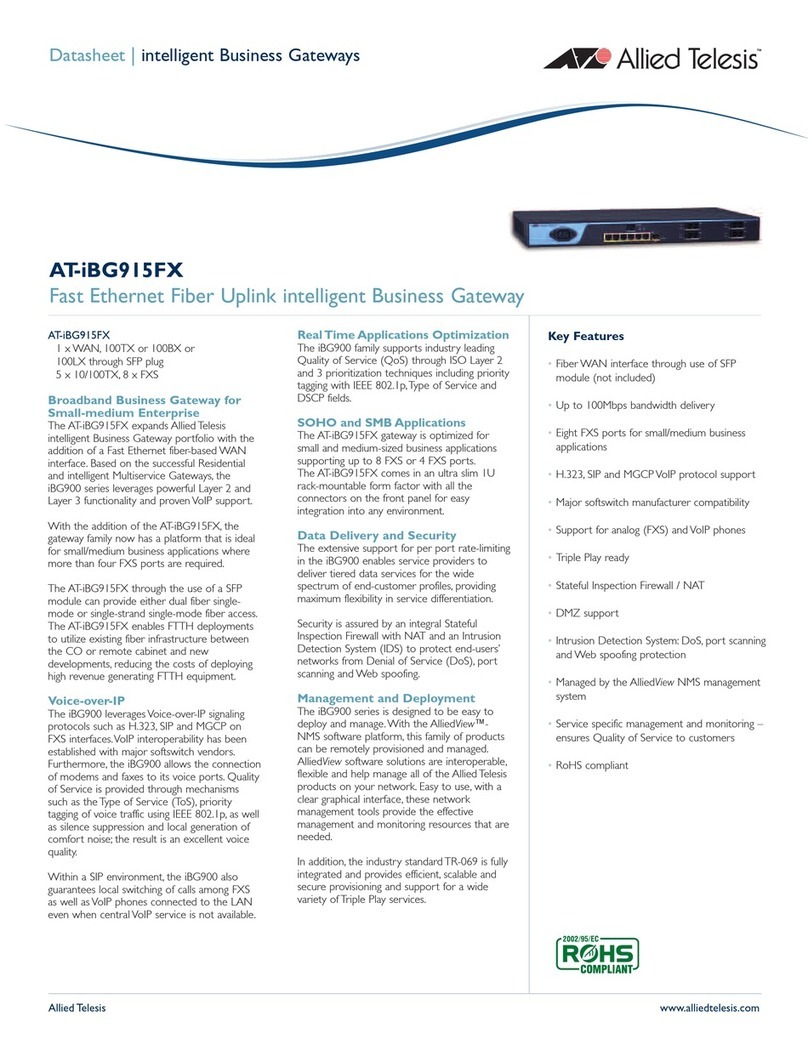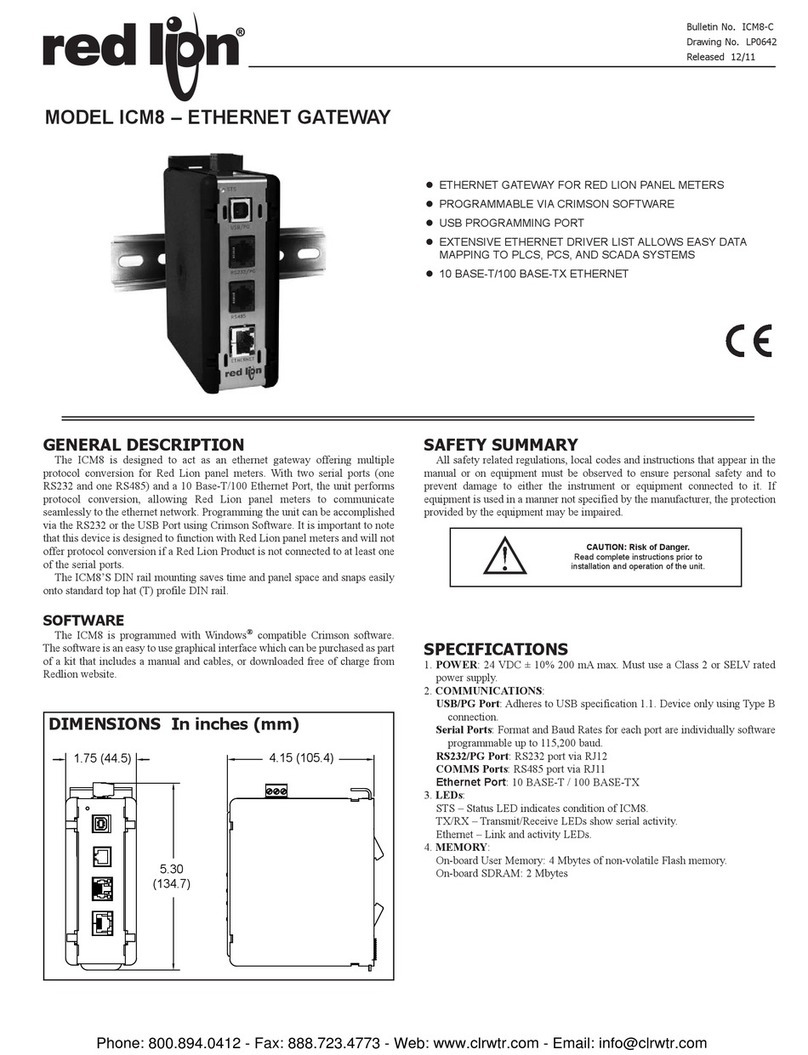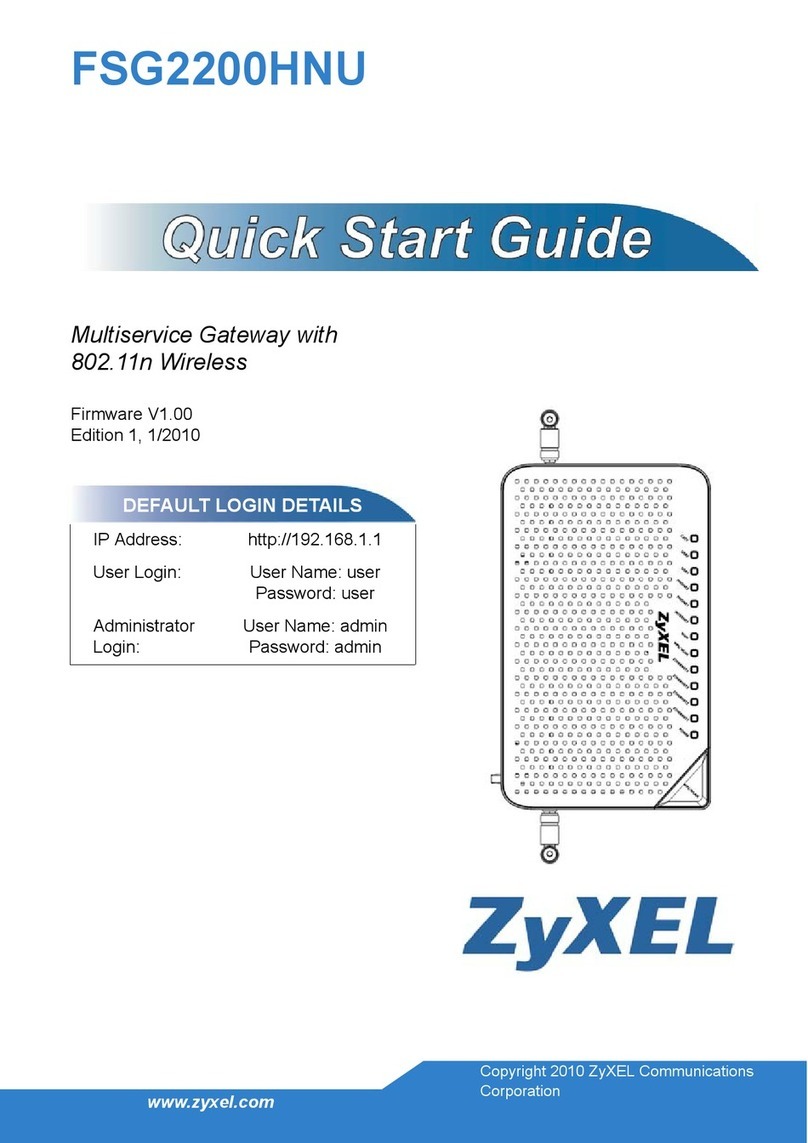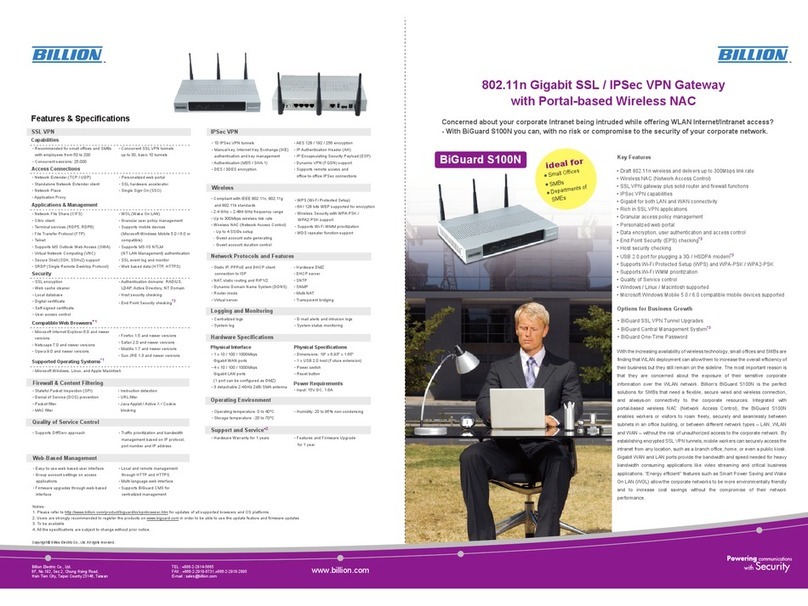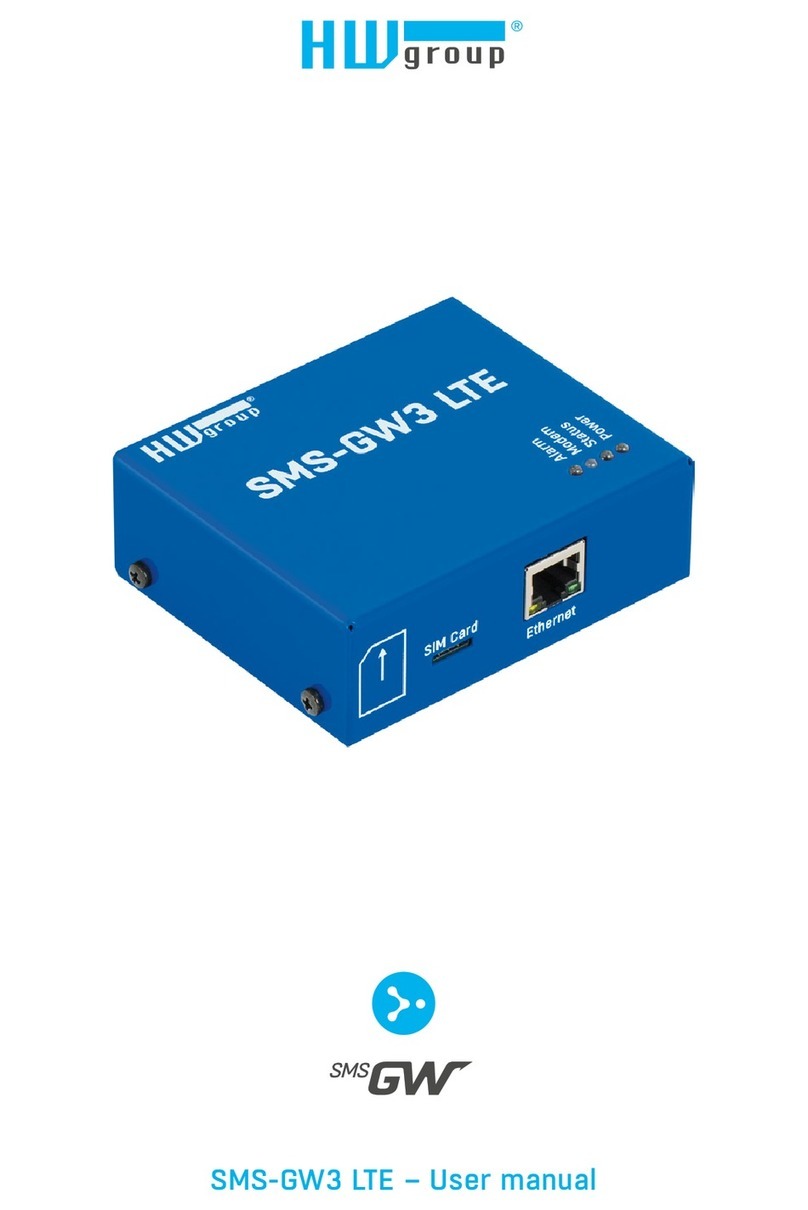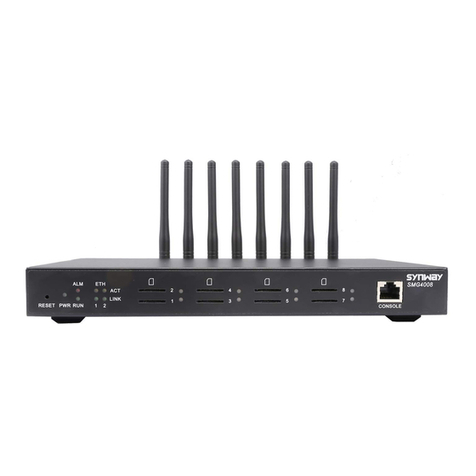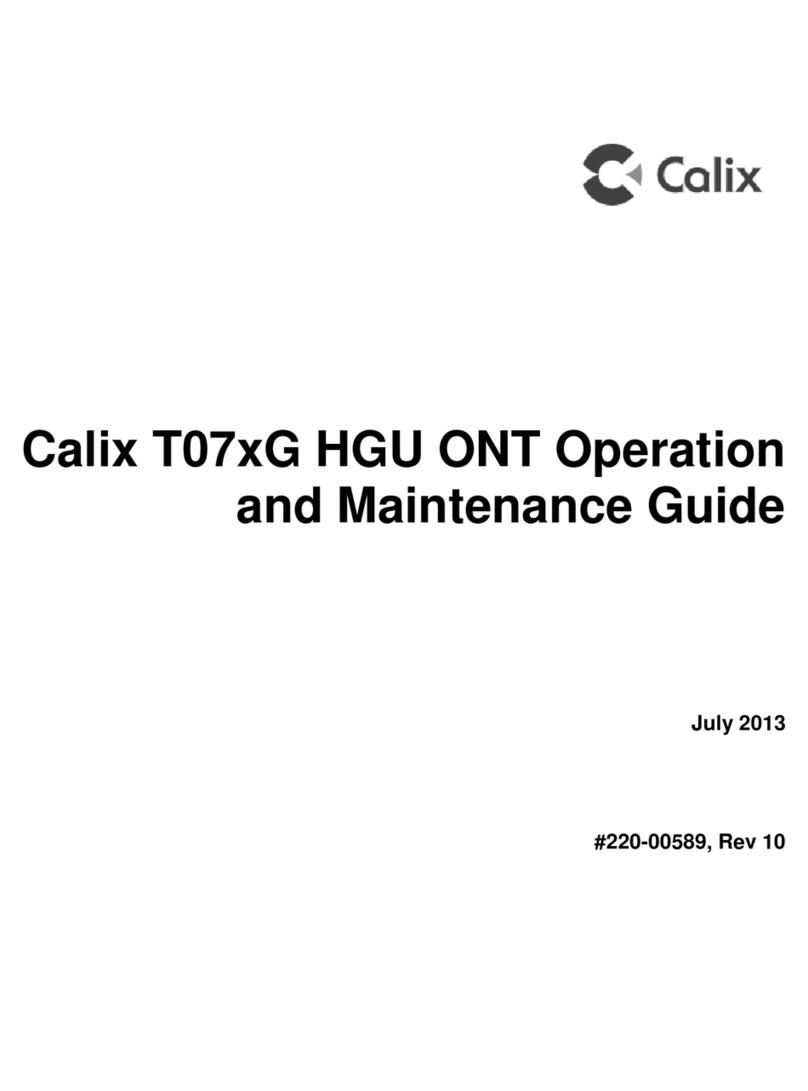David Clark 3800 U9922-G38 User manual

19541P-43 (03-12)
2012 DAVID CLARK COMPANY INCORPORATED
USER MANUAL
3800 Gateway
U9922-G38
(P/N: 40995G-01)


19541P-43 (03-12) 1 of 9
C
Ca
au
ut
ti
io
on
ns
s
a
an
nd
d
W
Wa
ar
rn
ni
in
ng
gs
s
READ AND SAVE THESE INSTRUCTIONS. Follow the instructions in this installation
manual. These instructions must be followed to avoid damage to this product and
associated equipment. Product operation and reliability depends on proper usage.
DO NOT INSTALL ANY DAVID CLARK COMPANY PRODUCT THAT
APPEARS DAMAGED. Upon unpacking your avid Clark product,
inspect the contents for shipping damage. If damage is apparent,
immediately file a claim with the carrier and notify your avid Clark
product supplier.
ELECTRICAL HA ARD
-
isconnect electrical power when making any
internal adjustments or repairs. All repairs should be performed by a
representative or authorized agent of the avid Clark Company.
STATIC HA ARD
-
Static electricity can damage components.
Therefore, be sure to ground yourself before opening or installing
components.
LI-POLYMER - This product is used with Li-Polymer batteries. o not
incinerate, disassemble, short circuit, or expose the battery to high
temperatures. Battery must be disposed of properly in accordance
with local regulations.

19541P-43 (03-12) 2 of 9
O
Ov
ve
er
rv
vi
ie
ew
w
The U9922-G38 (40995G-01) 3800 Gateway is a fixed-mounted wireless communication device
that when used in conjunction with one or more U9910-BSW (40992G-01) or U9912-BSW
(40992G-02) Wireless Belt Stations becomes part of a wireless intercom system. The U9922-
G38 provides communication for up to four users as well as an interface to an existing avid
Clark Model 3800 wired intercom system. Additionally, the U9922-G38 can be used as a stand-
alone wireless intercom gateway with two-way radio interface. Up to four belt stations can be
connected to one gateway.
Radio
Input
Status LED
VOLUME LINK
Antenna
System
Input R
Figure 1: Overview of Gateway

19541P-43 (03-12) 3 of 9
I
In
ns
st
ta
al
ll
la
at
ti
io
on
n
Intercom Interface
The U9922-G38 can be configured in one of two ways: 3800 interface and stand-alone.
3800 Interface
This configuration adds wireless capability to an existing 3800 wired intercom system and
can replace a U3811 or U3815 radio interface module (see 3800 system documentation
for further details.) In this way, all wired and wireless users may communicate with each
other as well as talk over and listen to a two-way radio. A C38-xx system cable and
optional C3821 radio interface cable are required for this configuration.
Stand-alone
Stand-alone configuration creates an ad-hoc wireless intercom and adds access to a two-
way radio. This configuration does not connect to a 3800 wired intercom system. A C99-
22PW (18748G-24) power cable and optional C3821 radio interface cable are required for
this configuration.
Antenna
The U9922-G38 has two external antenna connections and is supplied with one whip style
antenna. In most applications a single whip antenna is sufficient. However the optional remote
antenna kit (P/N: 40688G-93 for mag-mount, 40688G-96 for permanent install) is available
should more range be desired. In this case, we recommend keeping one whip antenna
connected directly to the U9922-G38 and routing the remote antenna somewhere else (such as
on the roof of a vehicle).
Choose an open, clear location for the remote antenna and route the coaxial cable away from
any busy areas, preferably behind panels or in conduits.
This device has been designed to operate with the antennas listed below, and having a
maximum gain of 3 dB. Antennas not included in this list or having a gain greater than 3 dB are
strictly prohibited for use with this device. The required antenna impedance is 50 ohms.
Acceptable antennas for use with this product:
•Whip Antenna (P/N: 40688G-92)
•Remote Antenna Kit, Mag-Mount (P/N: 40688G-93)
•Remote Antenna Kit, Permanent (P/N: 40688G-96)

19541P-43 (03-12) 4 of 9
L
Li
in
nk
ki
in
ng
g
Before a belt station and a gateway can be connected, they must first be linked. As a security
measure, the close-link feature requires devices to be in proximity of about 1 to 3 ft (0.3 to 0.9m)
in order to successfully link. This ensures that the units are not inadvertently linked with other
units on the premises.
Linking procedure:
1. Ensure units are within 1 to 3 ft (0.3 to 0.9m) of each other.
2. Simultaneously (within 1-2 sec) press and release the LINK button on the U9922-G38 and
the LINK/PTT button on the belt station to link with.
3. Amber LE ’s will flash quickly on both devices. A momentary red LE indicates a
successful close-link.
4. Upon successful link the U9922-G38 will attempt to establish a connection with the belt
station.
5. Upon successfully establishing connection the LE on the gateway will flash a green
pattern corresponding to the number of belt stations connected.
Tip:
Once linked, the devices will not need to be linked again unless they are purged (see
Purging).
Each belt station is able to be linked to only one gateway at a time. A gateway can have up to six
belt stations linked and be connected to four of those six at one time.
S
St
ta
at
tu
us
s
I
In
nd
di
ic
ca
at
ti
io
on
ns
s
The LINK button has a multi-color LE in the center which serves as a status indication for the
gateway. Table 1 below lists these states.
Table 1: LED Status Indications
LED Color
Blink Rate
Status
Red
Solid
Initializing/power up
Red
Once
Connection ropped
Red
Once
Connection Established
Red
Any
Low battery (approx. 1 hr remaining)
Orange
Slow
Idle/ isconnected
Orange
Fast
Linking/Connection in Progress
Orange
Solid
PTT asserted
Green
Slow
Connected (pattern indicates
number of belt stations connected)

19541P-43 (03-12) 5 of 9
O
Op
pe
er
ra
at
ti
io
on
n
Communication
All connected belt stations will be able to communicate with each other through the U9922-G38
while in range (and per the VOX settings on each VOX belt station.) Additionally, all belt station
users will have communication over the intercom. If a two-way radio is installed to the U9922-
G38, pressing the PTT button on a VOX belt station will allow the user to transmit over the
system’s two-way radio. Pressing the PTT overrides the VOX setting on a VOX belt station.
Multiple belt station users may PTT and thus speak over the two-way radio simultaneously. For
more information consult the user manual for the belt station.
Tip:
Wireless users who are not pressing PTT while another wireless user is pressing PTT will
not be heard on the wired intercom while the PTT remains pressed.
Intercom Level Adjustment
Audio levels can vary between intercoms, mainly due to the system level setting on the wired
intercom. To compensate for this, the U9922-G38 has the ability to adjust its receive level from
the intercom using the Volume knob (see Figure 1). Turning this knob will increase or decrease
the audio level coming from the wired intercom into the gateway. Perform this adjustment to
obtain optimum performance.
Intercom Level Adjustment Procedure
1. Connect at least one belt station to the U9922-G38 gateway and ensure sidetone is
present (see belt station User Manual).
2. Begin speaking and slowly turn the Volume knob on the U9922-G38 clockwise until
you hear an echo of your own voice.
3. Continue speaking and turn the Volume knob counter-clockwise until the echo stops.
4. You may wish to verify communication with someone hard-wired to the intercom.
Radio Level Adjustment
Audio levels to and from a two-way radio can also vary between radio models and
manufacturers. To adjust the U9922-G38 for a particular radio, follow the procedures below.

19541P-43 (03-12) 6 of 9
Radio Transmit Level Adjustment Procedure
Note: A radio service monitor is recommended for this adjustment.
1. Connect at least one belt station to the U9922-G38 gateway and ensure sidetone is
present (see belt station User Manual).
2. Open the cover of the U9922-G38 and find the large silver knob.
3. Press and hold the PTT and speak clearly and loudly into the microphone.
4. Slowly turn the knob until the radio service monitor reads 4.0-4.5kHz deviation.
a. Clockwise to increase level; counter-clockwise to decrease
Radio Receive Level Adjustment Procedure
1. Connect at least one belt station to the U9922-G38 gateway and ensure side-tone is
present (see belt station User Manual).
2. Open the cover of the U9922-G38 and find the large silver knob.
3. Tune the radio to a continuous transmission (such as NWS) or transmit a test signal
from another radio.
4. Adjust the volume control on the radio to a level slightly higher than typical.
5. Slowly turn the knob until you hear a loud and clear signal on the wireless intercom.
a. Clockwise to increase level; counter-clockwise to decrease
Range
The range of a belt station and a gateway can be up to 300ft (100m). If you are in an environment
with metal or concrete walls, this range could be reduced. If the belt station enters into a "fringe"
reception area, a brief sequence of three beeps will be heard in the headset. This is to serve as a
warning of a possible disconnection if conditions are not improved. When possible, the user
should attempt to regain line-of-sight contact with the controller. When the belt station travels
out of range of the gateway, a voice alert will indicate that the connection has been lost. To
reconnect, simply move back into range and connection with the gateway will automatically be
reestablished, also noted by a voice alert.
P
Pu
ur
rg
gi
in
ng
g
In some circumstances it may be necessary to “purge” the U9922-G38 of some of its linked belt
stations. Typically purging is not necessary unless there are multiple gateways in the same
vicinity and you wish to remove a belt station from this gateway and link to a different gateway.
A gateway can link up to six belt stations where a belt station can be linked to only one gateway
at a time.

19541P-43 (03-12) 7 of 9
Smart Purge
A smart purge is the purge method employed for the U9922-G38, in which only unwanted links
are removed from the gateway. When this procedure is complete, only belt stations that are
connected to the gateway remain linked. All other belt station links will have been removed (see
the belt station User Manual for the individual belt station purging procedure when remaining
link purging may be necessary.)
Smart Purge procedure
1. Ensure gateway is powered on and functioning.
2. isconnect all belt stations to be purged (power off the belt stations).
3. Verify the number of green LE flashes on the gateway matches the number of
belt stations to be kept linked.
4. Press and hold LINK button on the gateway for 30 seconds until LE quickly
flashes red.
5. Release LINK button.
T
Tr
ro
ou
ub
bl
le
es
sh
ho
oo
ot
ti
in
ng
g
Table 2: Troubleshooting
Problem
Solution
Gateway will not turn on
Review
Installation
procedure
Ensure wiring is correct.
Cannot link a belt station
Rev
iew
Linking
procedure
Ensure units are within 1 to 3ft (0.3 to 0.9m) of
each other
Try a Smart Purge
Cannot speak over two
-
way
radio
PTT not pressed
No radio connected to U9922-G38
R
Re
ep
pl
la
ac
ce
em
me
en
nt
t
P
Pa
ar
rt
ts
s
•System cable (C38-xx; number after dash indicates length in feet)
•Power Cable (C99-22PW, P/N:18748G-24)
•Radio Interface Cable (C3821, P/N: 18747G-06)
•Whip Antenna (P/N: 40688G-92)
•Remote Antenna Kit, Mag-Mount (P/N: 40688G-93)
•Remote Antenna Kit, Permanent (P/N: 40688G-96)

19541P-43 (03-12) 8 of 9
C
Ca
ar
re
e
a
an
nd
d
M
Ma
ai
in
nt
te
en
na
an
nc
ce
e
The U9922-G38 is not user serviceable. o not attempt to open the enclosure (unless adjusting
the radio level per the procedures noted in this manual.) If this product requires service, please
contact the avid Clark Customer Service department:
•Phone: 800.298.6235
•E-Mail: serviceWWW@ avidClark.com
•By Mail: Customer Service
avid Clark Company
360 Franklin Street
Worcester, MA 01604
If necessary, the U9922-G38 may be wiped down with a mild soap and water mixture. Although
it is a sealed device designed to withstand submersion in water to 1 meter, do not unnecessarily
submerse this product in water.
Avoid storage of this product in direct sunlight or high temperature environments.
S
Sp
pe
ec
ci
if
fi
ic
ca
at
ti
io
on
ns
s
Frequency Range
1920 M
Hz
-
1930 MHz (U.S. and Canada)
Average RF Power Output
4 mW
(100mW peak) (U.S. and Canada)
Range
300 ft (100m) line
-
of
-
sight (nominal)
Operating Temperature
-
14°F to 113°F (
-
10°C to +45°C)
Storage Temperature
-
4°F to 140°F (
-
20°C to +60°C
)
Power Requirements
8 to 32 V C
F
FC
CC
C
P
Pa
ar
rt
t
1
15
5
S
St
ta
at
te
em
me
en
nt
t
RA IO AN TELEVISION INTERFERENCE
This equipment has been tested and found to comply with the limits for a Class B digital device,
pursuant to Part 15 of the FCC rules. These limits are designed to provide reasonable protection
against harmful interference in a residential installation. This equipment generates, uses and can
radiate radio frequency energy and, if not installed and used in accordance with the instructions,
may cause harmful interference to radio communications. However, there is no guarantee that
interference will not occur in a particular installation. If this equipment does cause harmful
interference to radio or television reception, which can be determined by turning the equipment
off and on, the user is encouraged to try to correct the interference by one or more of the
following measures:

19541P-43 (03-12) 9 of 9
- Reorient or relocate the receiving antenna.
- Increase the separation between the equipment and the receiver.
- Connect the equipment into an outlet on a circuit different from that to which the receiver is
connected.
- Consult the dealer or an experienced radio/TV technician for help.
You may also find helpful the following booklet, prepared by the FCC: "How to Identify
and Resolve Radio-TV Interference Problems." This booklet is available from the U.S.
Government Printing Office, Washington .C. 20402.
* In order to maintain compliance with FCC regulations shielded cables must be used with
this equipment. Operation with non-approved equipment or unshielded cables is likely to result
in interference to radio & television reception.
I
In
nd
du
us
st
tr
ry
y
C
Ca
an
na
ad
da
a
S
St
ta
at
te
em
me
en
nt
t
This device complies with Industry Canada licence-exempt RSS standard(s). Operation is subject
to the following two conditions: (1) this device may not cause interference, and (2) this device
must accept any interference, including interference that may cause undesired operation of the
device.
U
Un
na
au
ut
th
ho
or
ri
iz
ze
ed
d
C
Ch
ha
an
ng
ge
es
s
Changes or modifications not expressly approved by avid Clark Company, Inc. could void the
users’ authority to operate the equipment.
F
FC
CC
C
R
Ra
ad
di
ia
at
ti
io
on
n
E
Ex
xp
po
os
su
ur
re
e
S
St
ta
at
te
em
me
en
nt
t
This equipment complies with FCC radiation exposure limits set forth for an uncontrolled
environment. This equipment should be installed and operated with a minimum distance of 20
centimeters (8 inches) between the radiator (antenna) and your body. This transmitter must not
be co-located or operating in conjunction with any other antenna or transmitter.
U
Us
sa
ag
ge
e
R
Re
es
st
tr
ri
ic
ct
ti
io
on
ns
s
ue to the UPCS frequencies used, this product is licensed for operation only in the United States
of America and Canada.
This manual suits for next models
1
Other David Clark Gateway manuals
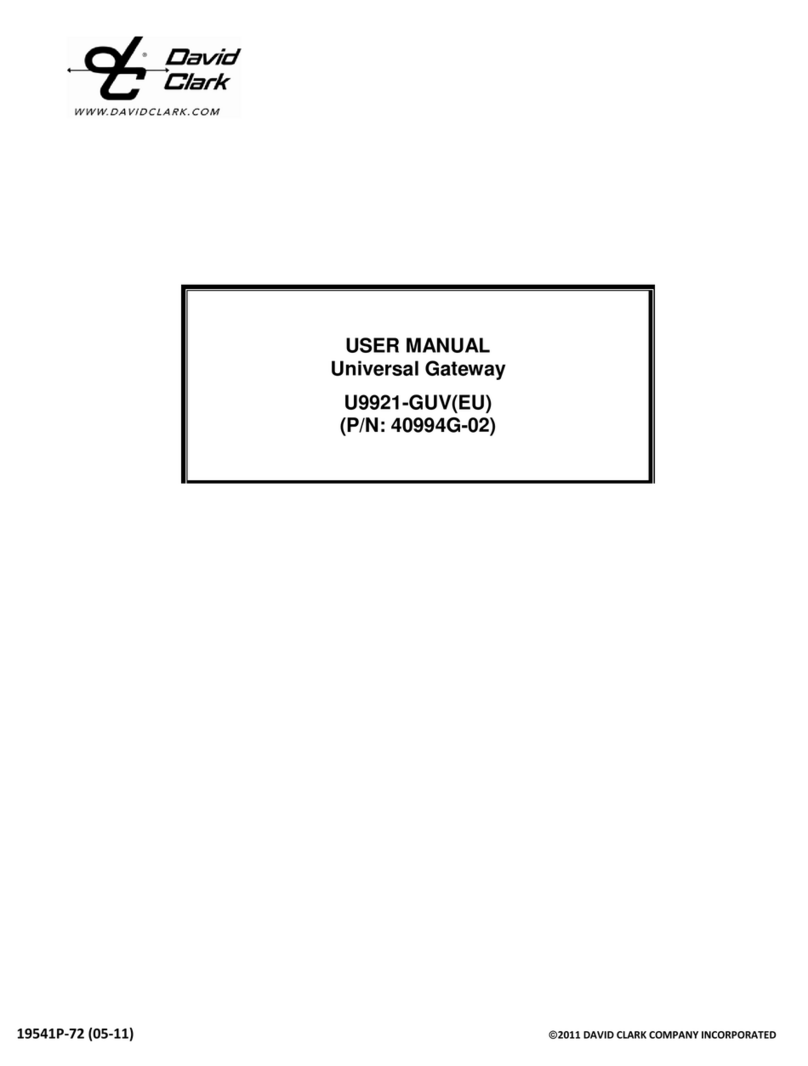
David Clark
David Clark U9921-GUV User manual
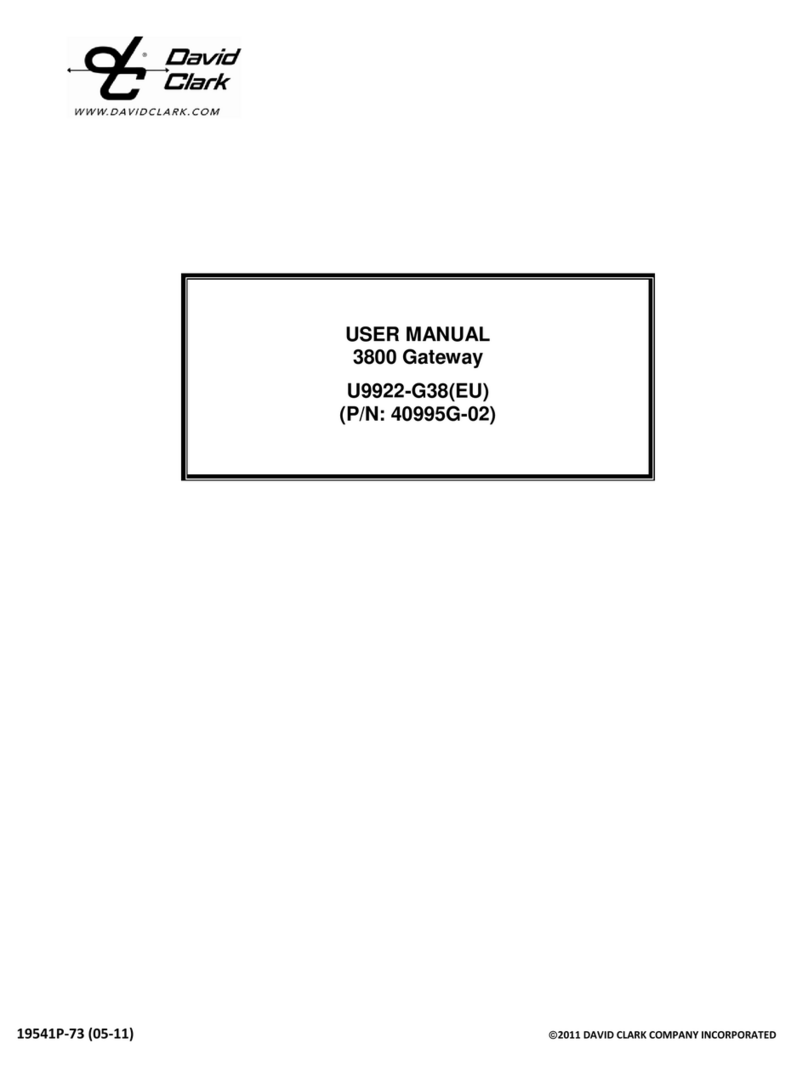
David Clark
David Clark 3800 User manual
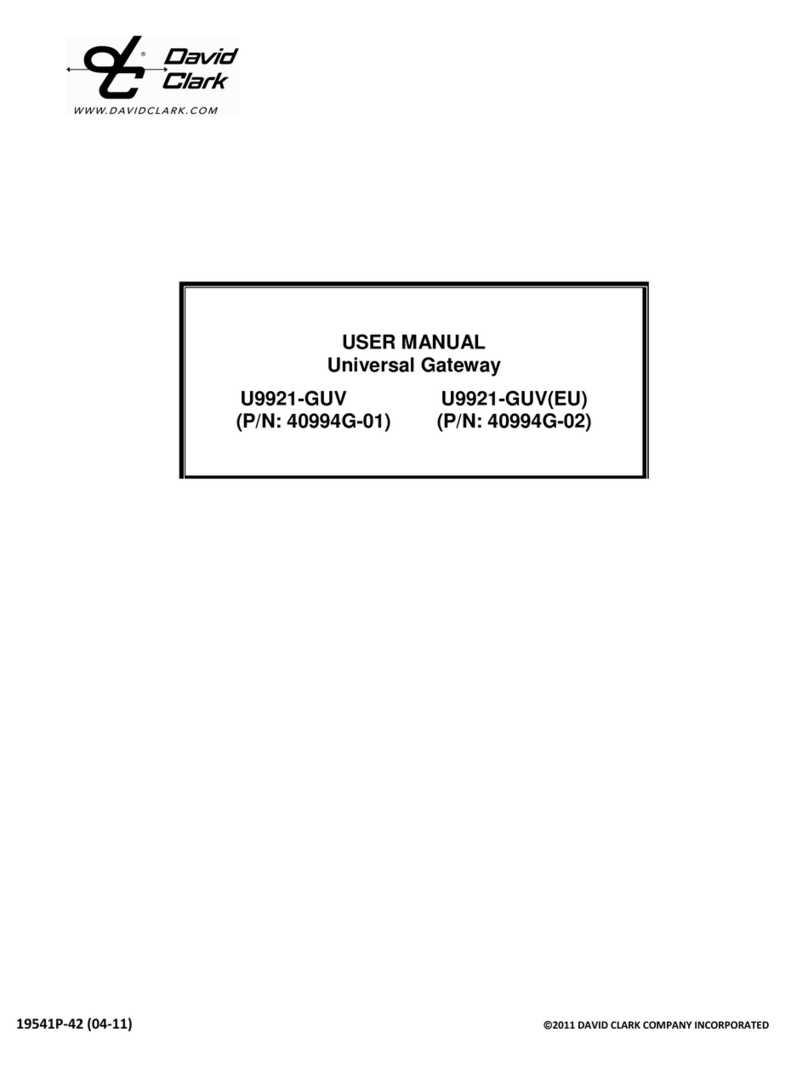
David Clark
David Clark U9921-GUV User manual
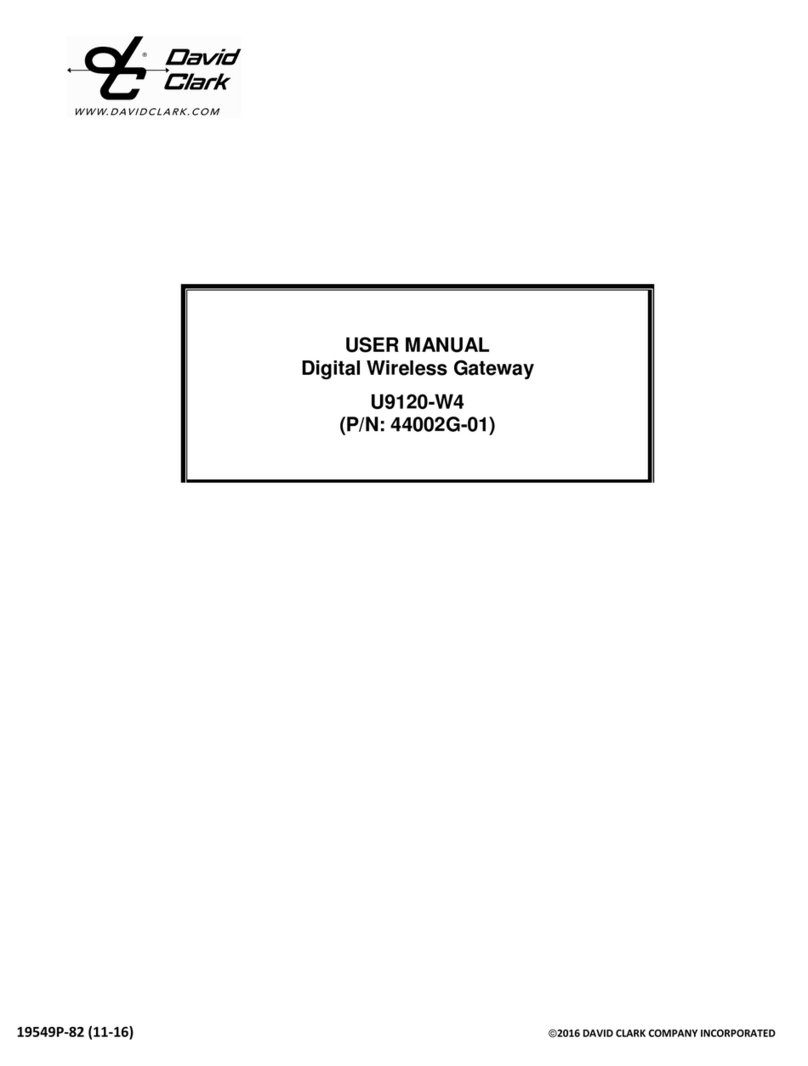
David Clark
David Clark 44002G-01 User manual
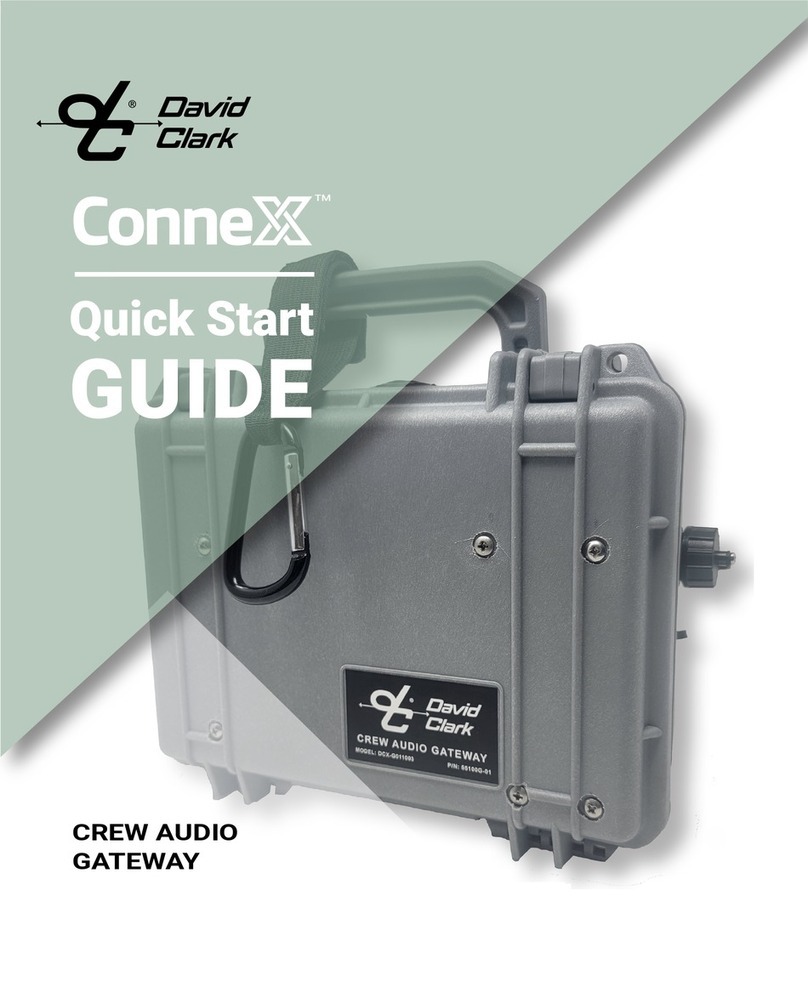
David Clark
David Clark ConneX CREW User manual
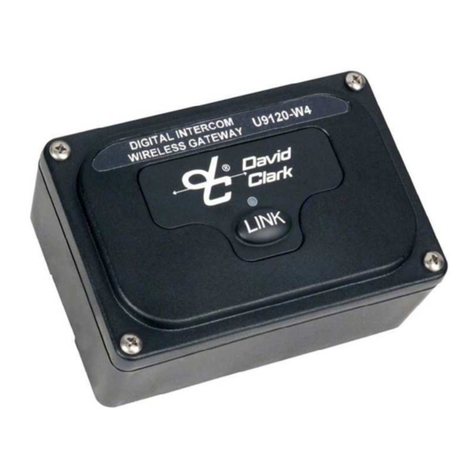
David Clark
David Clark U9120-W4 User manual

David Clark
David Clark U9921-GUV User manual
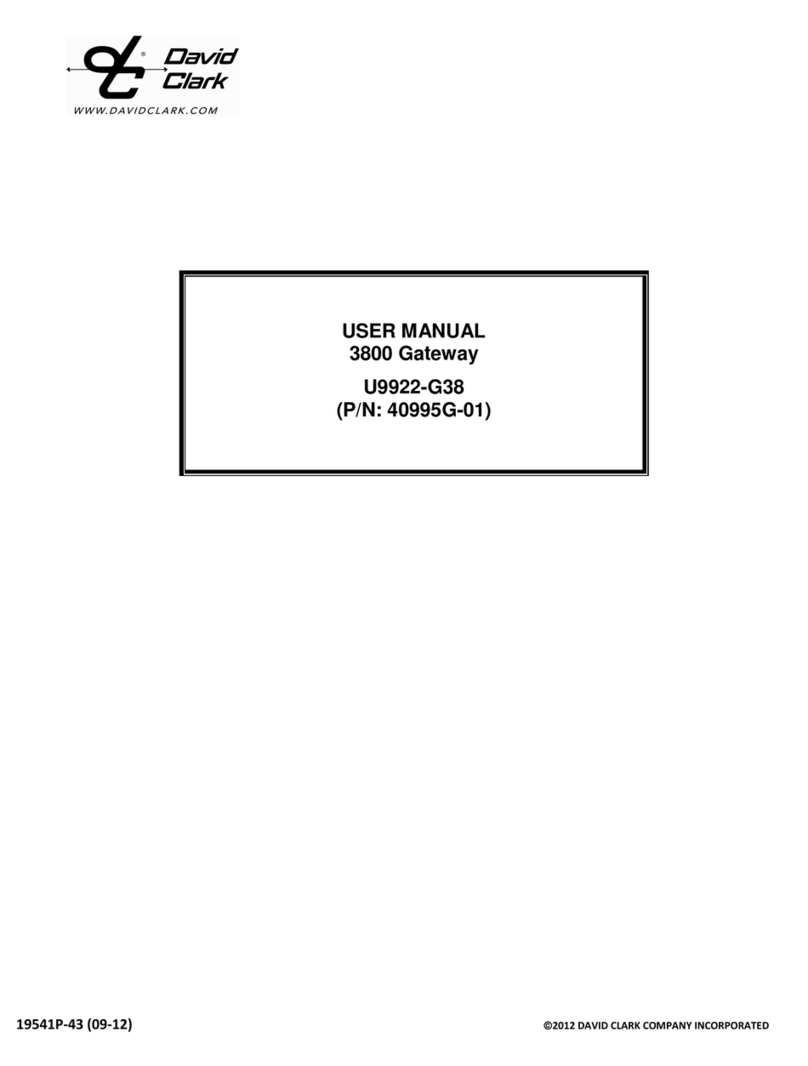
David Clark
David Clark U9922-G38 User manual
Popular Gateway manuals by other brands

IPitomy
IPitomy IP400 quick start guide

RTA
RTA 460ESETC-NNA1 Product user guide
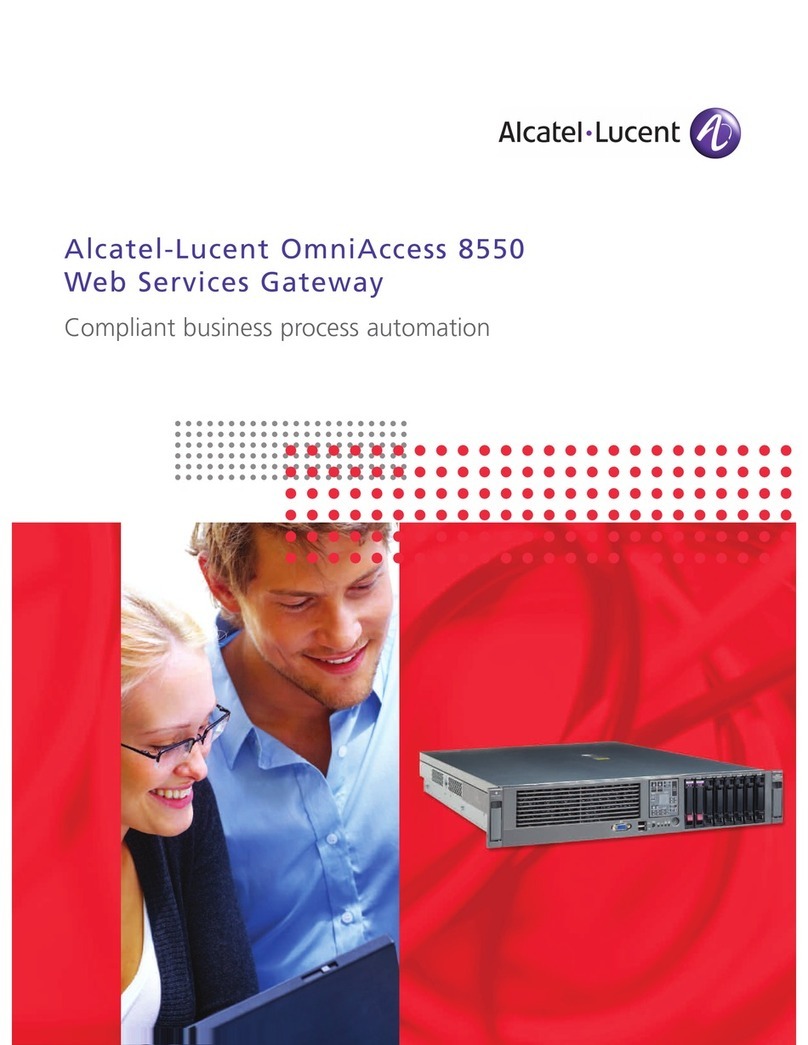
Alcatel-Lucent
Alcatel-Lucent OmniAccess 8550 brochure

Mediastar
Mediastar 783 quick start guide
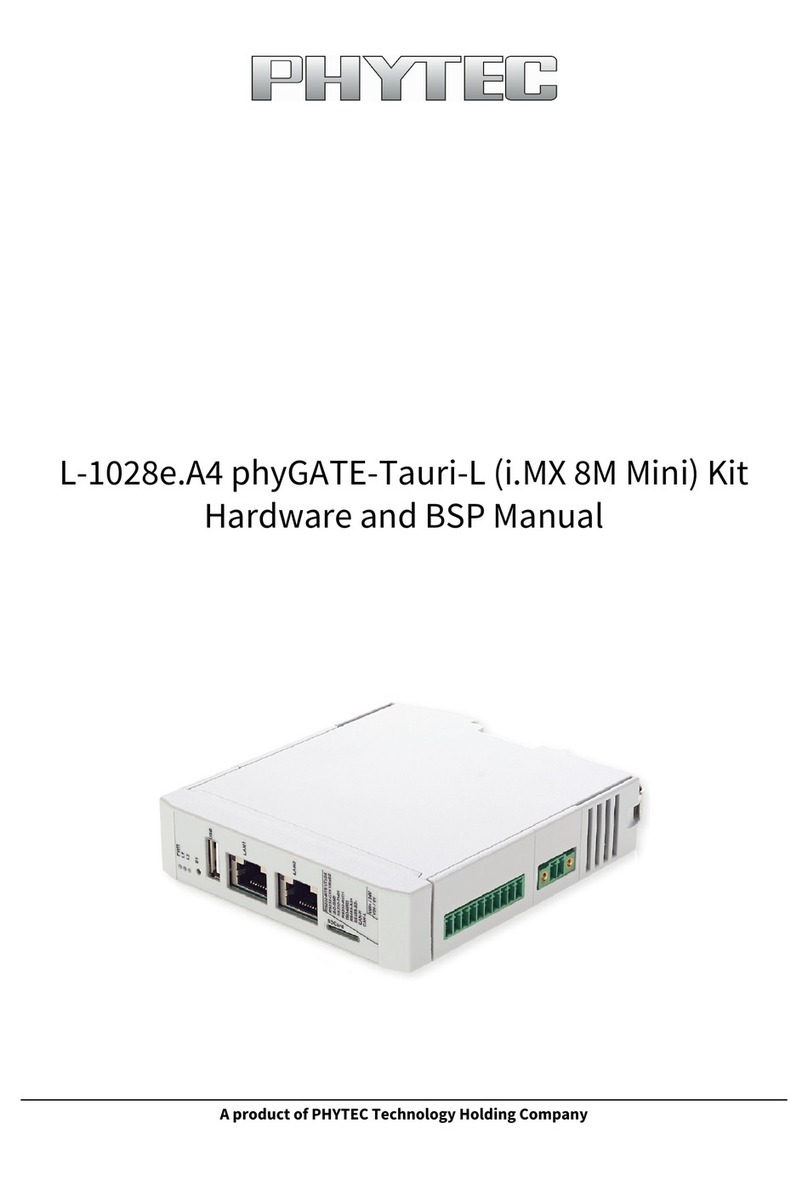
Phytec
Phytec phyGATE Tauri-L Hardware manual
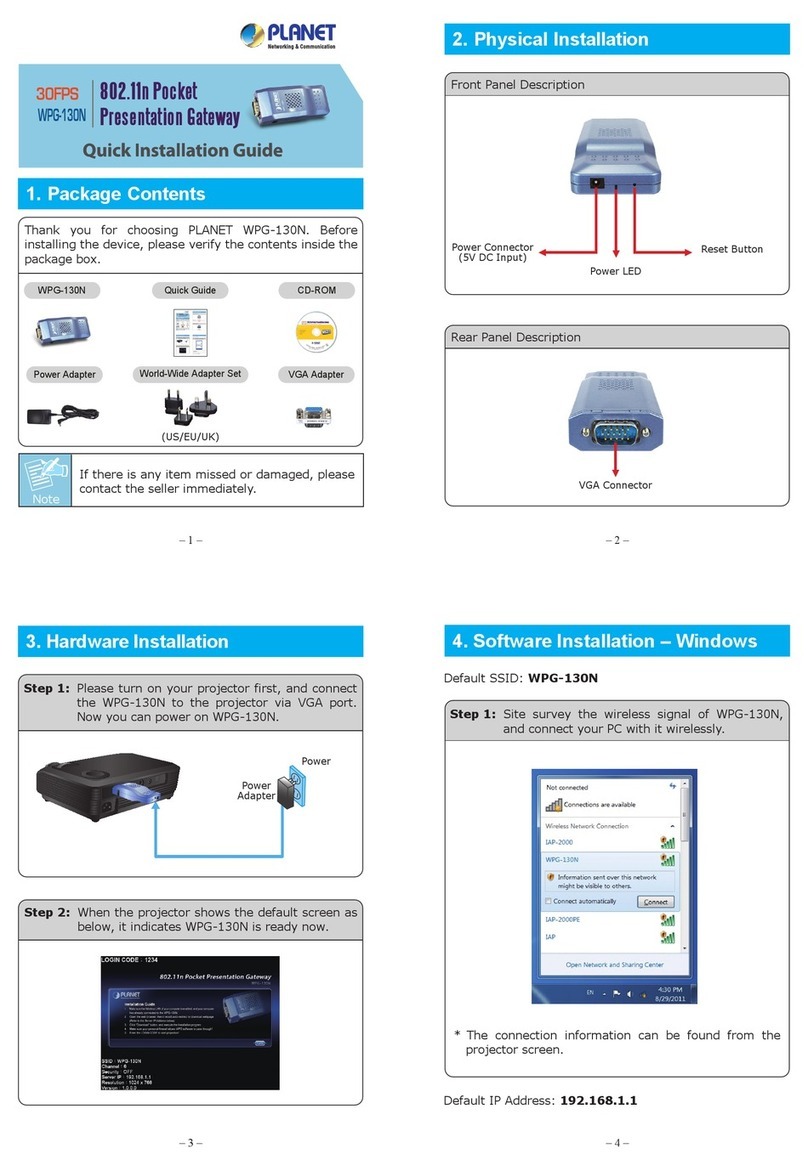
Planet Networking & Communication
Planet Networking & Communication WPG-130N Quick installation guide
